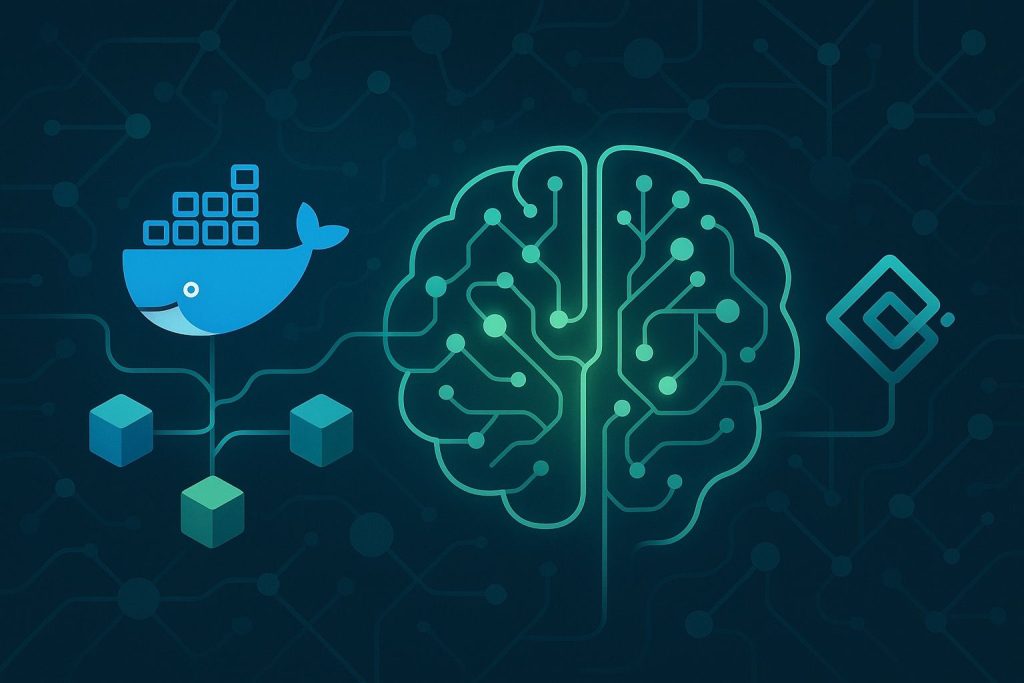
Introduction
Running sophisticated AI workflows locally can save costs while giving you complete control over your data and processes. By combining Docker containerization with Model Context Protocol (MCP), you can create a powerful, flexible AI environment on your own hardware. This guide will walk you through setting up this advanced yet accessible workflow.
What is MCP?
Model Context Protocol (MCP) is an open standard developed by Enthropic that enables AI applications to interact seamlessly with:
- External data sources
- Various services
- Your local file system
- Custom-built tools
The real power of MCP lies in its ability to let large language models discover and execute appropriate tools within the right context, creating more intelligent and responsive AI systems. For developers, this means building AI workflows that can adapt to different situations without constant manual intervention.
Docker: Your Container Solution
Docker provides isolated environments (containers) that package everything needed to run applications:
- The application code
- Runtime dependencies
- System tools
- Libraries
- Settings
This isolation ensures consistent performance across different computing environments and eliminates compatibility issues. If you’re unfamiliar with Docker, here’s what makes it essential for AI workflows:
- Consistent environments: Your AI tools will run identically regardless of the host system
- Easy deployment: Bundle complex applications with all dependencies
- Resource efficiency: Containers share OS resources while remaining isolated
- Scalability: Scale containers up or down based on workload needs
To get started, download Docker Desktop for your operating system, which provides a user-friendly interface to manage your containers.
Introducing Nan for Workflow Automation
Nan is an open-source automation tool that runs within Docker and provides a visual interface for connecting services and executing tasks. Key features include:
- Visual workflow builder
- Node-based automation
- Single-container operation
- Community-contributed nodes for extended functionality
Once you have Docker Desktop installed, you can pull and run Nan with a simple Docker command:
bashdocker pull ghcr.io/nan-io/nan:latest
docker run -p 3000:3000 ghcr.io/nan-io/nan:latest
After running these commands, access the Nan interface at http://localhost:3000 in your web browser.
Integrating MCP with Nan
The real magic happens when you integrate MCP directly into your Nan workflows. This integration allows your AI agents to:
- Access external tools and data sources
- Process information contextually
- Execute actions based on that context
- Return meaningful results
Enthropic’s partnership with Docker has made this integration even more powerful, allowing you to run cloud desktop environments with containerized MCP servers for enhanced versatility.
Building Your First AI Workflow
Let’s create a basic AI workflow using Nan and MCP:
Step 1: Create a Trigger
In Nan, configure a chat trigger that will initiate your AI agent whenever a message is received. This serves as the entry point for your workflow.
Step 2: Add MCP Clients
Configure MCP clients within your Nan environment to connect your AI agents with external tools. Common tools include:
- Web search capabilities
- Document processing
- Data analysis functions
- API connections
Step 3: Configure Agent Responses
Set up how your agent will respond to different inputs and what actions it should take based on context. For example, when a question requires factual information, the agent can automatically invoke the web search tool.
Step 4: Test and Refine
Run your workflow with test queries and refine as needed. The visual interface makes it easy to identify bottlenecks or areas for improvement.
Advanced Configurations
As you become more comfortable with this setup, you can expand your AI workflow with:
- Multiple specialized agents: Create different agents for specific tasks
- Custom tools: Develop your own tools that interface with MCP
- Workflow chains: Connect multiple workflows for complex processing
- Persistent storage: Configure Docker volumes to maintain data between sessions
Benefits of This Approach
This combination of technologies offers several key advantages:
- Cost-effective: Run sophisticated AI workflows locally without ongoing cloud costs
- Privacy-focused: Your data remains on your hardware
- Customizable: Adapt the workflow to your specific needs
- Open-source: Leverage community developments and contribute back
- Scalable: Start small and expand as your needs grow
Technical Considerations
When implementing this workflow, keep these considerations in mind:
- Hardware requirements: More complex workflows require more powerful hardware
- Memory management: Configure Docker’s resource allocation based on your system capabilities
- Networking: Ensure proper port configurations for services that need to communicate
- Security: Apply best practices for securing your Docker containers
Resources for Further Learning
If you want to dive deeper into these technologies, here are some valuable resources:
- Docker Documentation
- Enthropic MCP GitHub Repository
- Nan Project Documentation
- Introduction to Container Orchestration
Conclusion
Building a local AI workflow with Docker and MCP opens up powerful possibilities for automation and intelligent processing without depending on external services. The combination of Docker’s clean, consistent environments, Nan’s visual workflow automation, and MCP’s enhanced AI capabilities creates a robust foundation for developing sophisticated AI applications.
Whether you’re a developer looking to experiment with AI capabilities or an organization seeking to implement cost-effective AI solutions, this local workflow approach provides both flexibility and control. Start exploring today and discover how these technologies can transform your AI development process.
